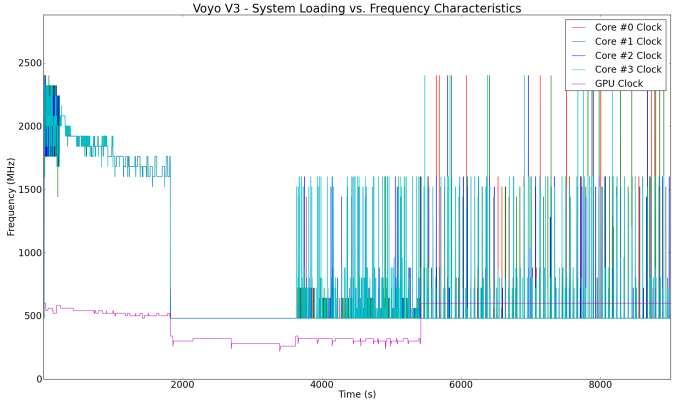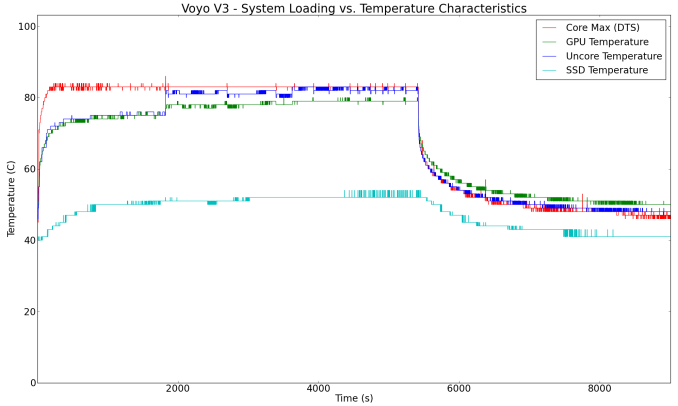Voyo V3 Review - A Fanless Intel Atom x7-Z8700 (Cherry Trail) mini-PC
by Ganesh T S on March 1, 2016 8:00 AM EST- Posted in
- Systems
- Intel
- Atom
- Passive Cooling
- Mini-PC
- Cherry Trail
Power Consumption and Thermal Performance
The power consumption at the wall was measured with a 1080p display being driven through the HDMI port. In the graphs below, we compare the idle and load power of the Voyo V3 with other low power PCs evaluated before. For load power consumption, we ran Furmark 1.12.0 and Prime95 v27.9 together. Given that the BIOS of the machine is not really optimized, the idle power being more than most comparable PCs is not surprising.


The load power consumption numbers can also be easily explained. The Atom x7-Z8700 has a SDP of only 2W, and it is definitely less power hungry compared to the Intel Celeron N3000 in the ASRock Beebox. However, it does lose out to the Bay Trail Compute Stick - this could be due to the power consumption of the extra components on the board such as the PCIe - SATA bridge and the faster clocks in the Cherry Trail SoC.
Our thermal stress routine starts with the system at idle, followed by 30 minutes of pure CPU loading. This is followed by another 30 minutes of both CPU and GPU being loaded simultaneously. After this, the CPU load gets removed, allowing the GPU to be loaded alone for another 30 minutes. The various clocks in the system as well as the temperatures within the unit are presented below.
The core clocks briefly operate at the maximum turbo frequency (2.4 GHz), but gradually scale down to the base clock (1.6 GHz) as the load is sustained. Thankfully, the thermal solution is decent enough to prevent the SoC from throttling. The GPU clock measurement has the usual Intel 'bug' where the measured clock is the maximum clock rate even when the GPU is not loaded. As soon as the GPU starts getting loaded, it moves between 200 - 300 MHz while keeping the power consumption of the whole system around 10 W.
According to the official specifications, the junction temperature of the Atom x7-Z8700 is 90C. Fortunately, after enabling DTS in the BIOS, we find that the maximum temperature of any of the board components is kept below 85C even under extreme stress.
Another important aspect to keep note of while evaluating fanless PCs is the chassis temperature. Using the Android version of the FLIR One thermal imager, we observed the chassis temperature after the CPU package temperature reached the steady state value in the above graph. Note that the picture below was taken after manually turning up the operating unit to expose the underside (metallic part abutting the black thermal film which covers the main board components).
We have additional thermal images in the gallery below.
The good part here is that even under extreme stress, the chassis doesn't heat up beyond 50 C. The bad part is that a lot of performance is left on the table (in terms of allowing the SoC to sustain turbo clocks for a longer duration) due to inefficient thermal design. Allowing for the metallic segment to be on top to aid convective cooling would have definitely helped in making the thermal performance better.



















69 Comments
View All Comments
blepowerranger - Friday, March 4, 2016 - link
If Intel wants my money, they better make damn sure it works out of the box with Linux.So it is Intel's problem you see?
kyuu - Saturday, March 5, 2016 - link
Sure, but considering the small size of the die-hard Linux community, it almost certainly doesn't make sense to expend the resources supporting Linux for such a small revenue stream, when they can devote the resources to other areas with much more profitability.blepowerranger - Tuesday, March 8, 2016 - link
Hello 1995, welcome to 2016! A world where most phones, TV's, servers and all sorts of other stuff runs Linux. In a world where the die-hard Windows community is shrinking, it's ill advised to miss "the next big thing".Arnulf - Wednesday, March 2, 2016 - link
I wonder if Cherry Trail can run Windows 7. Can anyone elaborate on that?BrokenCrayons - Wednesday, March 2, 2016 - link
Intel doesn't supply Windows 7 drivers for Cherry Trail. The why behind that fact...I'm not sure. Maybe someone else can speak to that.Namisecond - Monday, March 7, 2016 - link
Try the windows 8 drivers (Assuming there are windows 8 drivers), sometimes it works well enough with windows 7.SeanJ76 - Wednesday, March 2, 2016 - link
Rip off of a NUC.....derpSeanJ76 - Wednesday, March 2, 2016 - link
That doesnt even run Windows Server.....what a joke!NUC's cost 350$ bare boned. Add a 240GB M2 SSD and a couple sticks of memory and your set.
speculatrix - Sunday, March 6, 2016 - link
Totally agree. I have a Toshiba Click Mini, a z3735f Baytrail convertible tablet which works well with Windows 8.1 and more recently Windows 10.I've got to the point where Linux is useable, with the keyboard dock and it's usb and SDHC slot working, but neither camera works, nor sound, nor Bluetooth. Rarely but annoyingly it locks solid, which i think is the video.
nathanddrews - Tuesday, March 1, 2016 - link
Theoretically, the Type-C port could be used as a 4K60 transport if the display or adapter were available?